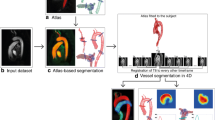Abstract
To derive blood flow dynamics from cine-angiograms (CAGs), we have developed an image-processing algorithm to determine a two-dimensional blood flow velocity map projected on CAGs. Each image data of CAG is divided into a set of overlapping blocks, and it is assumed that the contrast medium in each block moves only to its ‘adjacent blocks’ between two serial frames. Based on this assumption, a ‘fundamental equation’ and the ‘maximum flow constraints’ are derived. These equations state the relationship between the volume of contrast medium in each block and the volume of contrast medium flowing from/to its ‘adjacent blocks’. The volume of the flowing contrast medium is calculated using these relationships, boundary conditions and an additional ‘smoothness constraint’. The blood flow velocities are estimated from the volume of the flowing contrast medium and are illustrate with a needle diagram. We applied our algorithm to an abdominal CAG (clinical data). The result showed a vortex flow in the abdominal aneurysm, which was consistent with visual inspection of the CAG movie and with the existence of thrombus in the aneurysm. Our algorithm may be a useful diagnostic tool to assess vascular disease.
Similar content being viewed by others
References
Cunningham, L. A., Hobbs, B. B., andFenster, A. (1986): ‘A new system for quantitative arterial imaging and blood flow measurements’,Invest. Radiol.,21, pp. 465–471
Fermor, U., Huber, H., Neuhaus, K. L., Schmiel, F. K., andSpiller, P. (1979): ‘Measurement of flow velocity in the model circulation by video densitometry: methodological investigations’,Basic Res. Cardiol.,73, pp. 361–377
Hesselink, R., Chang, K. H., Chung, K. J., andAbbate, L. (1986): ‘Flow analysis with digital subtraction angiography’,Amer. J. Neuroradiol.,7, pp. 423–431
Horn, B. K. P., andSchunck, B. G. (1981): ‘Determining optical flow’,Artif. Intell.,17, pp. 185–203
Kjaernes, M., Svindland, A., Walloe, L., andWille, A. O. (1981): ‘Localization of early atherosclerotic lesions in an arterial bifurcation in humans’,Acta. Path. Microbiol. Scand. Sect.,A89, pp. 35–40
Liu, M. W., Roubin, G. S., andKing, B. III. (1989): ‘Restenosis after coronary angioplasty’,Circ.,79, pp. 1374–1387
Lois, J. F., Mankovich, N. J., andGomes, A. S. (1987): ‘Blood flow determinations utilizing digital densitometry’,Acta Radiol. 28, pp. 635–641
Mailloux, E., Langlois, F., Simard, P. Y., andBertrand, M. (1989): ‘Restoration of the velocity field of the heart from two-dimensional echocardiograms’,IEEE Trans.,MI-8, pp. 143–153
Margot, R. (1963): ‘An experimental study of the production and time course of poststenotic dilatation in the femoral and carotid arteries of adult dogs’,Circ. Res.,13, pp. 537–551
Rosen, J. B. (1960): ‘The gradient projection method for nonlinear programming part I. Linear constraints’,SIAM J. Appl. Math.,8, pp. 181–217
Schettler, G., Nerem, R. M, Schmid-Schönbein, H., Mörl, H., andDiehm, C. (Eds) (1983): ‘Fluid dynamics as a localizing factor for atherosclerosis’, (Springer-Verlag)
Seifalian, A. M., Hawkes, D. J., Colchester, A. C. F. andHobbs, K. E. F. (1989): ‘A new algorithm for deriving pulsator blood flow wave-forms tested using simulated dynamic angiographic data’,Neuroradiol. 31, pp. 263–269
Show, C. G., andPlewes, D. B. (1986): ‘Pulsed-injection method for blood flow velocity measurement in intraarterial digital angiography’,Radiol.,160, pp. 556–559
Spiller, P., Schmiel, F. K., Lits, B. P., Block, M., Fermour, U., Hackbarth, W., Jehle, J., Körger, R., andPannek, H. (1983): ‘Measurement of systolic and diastolic flow rates in the coronary artery system by X-ray densitometry’,Circ.,68, pp. 337–347
Sugimoto, N., Yanagihara, Y., Sugahara, T., andUyama, C. (1991): ‘Determining blood flow vector map on cineangiograms. Proc. of second conference on biomechanics’Jpn. Soc. Mech. Eng., Osaka, Japan, pp. 73–74 (in Japanese)
Sugimoto, N., Yanagihara, Y., Sugahara, T., andUyama, C. (1992): ‘Estimating blood flow velocity map from cineangiograms’,Trans. IEICE,J75-DII, pp. 720–727(in Japanese)
Swanson, D. K., Myerowits, P. D., Hegge, J. O., andWatson, K. M. (1986): ‘Arterial blood-flow waveform measurement in intact animals: new digital radiological technique’,Radiol.,161, pp. 323–328
Vollmar, J. F., Paes, E., Paushinger, P., andHenze, H. (1989): ‘Aortic aneurysms as late sequelae of above-knee amputation’,Lancet,7, (ii), pp. 834–835
Author information
Authors and Affiliations
Rights and permissions
About this article
Cite this article
Sugimoto, N., Uyama, C., Sugahara, T. et al. Estimation of 2-D blood flow velocity map from cine-angiograms: Algorithm using overlapping block set and illustration of vortex flow in abdominal aneurysm. Med. Biol. Eng. Comput. 32 (Suppl 1), S178–S184 (1994). https://doi.org/10.1007/BF02523345
Received:
Accepted:
Issue Date:
DOI: https://doi.org/10.1007/BF02523345




